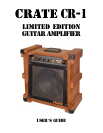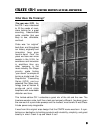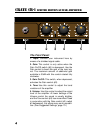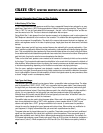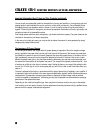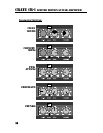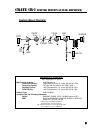
77
Important Information About Tubes and Tube Products (continued):
"looser" low-end response and produces more harmonics at mid and high frequencies ("creamier" sound).
These differences become more noticeable at higher volumes.
The EL84 and 6L6 tubes produce a big low-end thump and have a very good dynamic range. They offer a
more traditional "American Rock" sound. The EL84 and 6V6 tubes produce a creamy sound with nice dis-
tortion. On the other hand, the KT88 produces a big low-end but sounds more like an EL34 in the mid and
high frequencies.
The 6550 power tubes are more rugged and stay cleaner sounding even at full power. When they do dis-
tort, the sound produced is more solid and has a tighter low end; more of a "heavy metal" type distortion
with lots of power.
Some tubes are available in matched sets. These tubes have been extensively tested for optimum perform-
ance and longevity.
The Nature Of T
ubes:
Why (And When) T
o Replace Them:
Tubes are made up of a number of fragile mechanical components that are vacuum-sealed in a glass enve-
lope or bubble. The tube's longevity is based on a number of factors which include how hard and often the
amplifier is played, vibration from the speakers, road travel, repeated set up and tear down, etc.
Any time you notice a change in your amplifier's performance, check the tubes first.
If it's been a while since the tubes were replaced and the sound from your amplifier lacks punch, fades in
and out, loses highs or lows or produces unusual sounds, the power tubes probably need to be replaced. If
your amplifier squeals, makes noise, loses gain, starts to hum, lacks "sensitivity", or feels as if it is working
against you, the preamplifier tubes may need to be replaced.
The power tubes are subjected to considerably more stress than the preamplifier tubes. Consequently, they
almost always fail/degrade first. If deteriorating power tubes aren't replaced they will ultimately fail.
Depending on the failure mode, they may even cause severe damage to the audio output transformer
and/or other components in the amplifier. Replacing the tubes before they fail completely has the potential
to save you time, money and unwanted trouble. Since power tubes work together in an amplifier, it is cru-
cial that they (if there is more than one) be replaced by a matched set. If you're on the road a lot, we rec-
ommend that you carry a spare matched set of replacement power tubes and their associated driver tubes.
After turning off the power and disconnecting the amplifier from the power source, carefully check the tubes
(in bright light) for cracks or white spots inside the glass or any other apparent damage. Then, with the
power on, view the tubes in a dark room. Look for preamplifier tubes that do not glow at all or power tubes
that glow excessively red.
Whenever you replace the power tube(s):
• Always have the amplifier's bias voltage checked by a qualified service center. Improper bias voltage will
cause degradation in performance and possibly damage the tubes and/or the amplifier. (See the section
below entitled, "The Importance of Proper Biasing", for more information on this subject).
• We highly recommend that you replace the driver tube(s) as well. The driver tube determines the shape and
amplitude of the signal applied to the power tube(s) and has to work almost as hard as the power tube(s).
CRATE CR-1 LIMITED EDITION GUITAR AMPLIFIER



